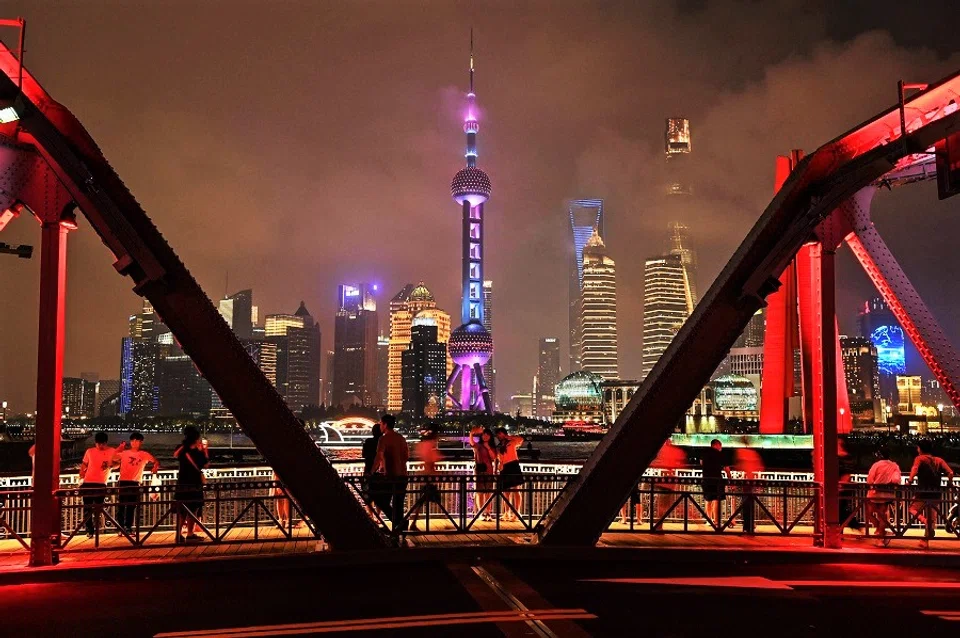The Shanghai middle class: Embracing 'cosmopolitanism with Chinese characteristics'?
Around 400 to 500 million Chinese citizens are thought to enjoy a middle-class lifestyle today. They are an important political and economic force but their political outlook and worldviews are neither homogeneous nor clear-cut. Many of them share certain cosmopolitan values, but some among them are also those with the most strident nationalistic views. How will this key demographic influence China's relations with the US and the world? Professor Li Cheng, author of Middle Class Shanghai: Reshaping US-China Engagement, tells us more.

There is no doubt that the Chinese middle class is a dominant political and economic force that will have a profound impact on both China and the world. But the political outlook and worldviews of this powerful contingent are far less clear-cut. Given that the rapid rise and explosive growth of China's middle class is a relatively recent development, its role and economic-political implications are neither predetermined nor stagnant. The dynamism and diversity of this new socioeconomic force and its transitory political role can undermine the fatalistic view about China's future trajectory.
At the centre of the story of the birth and growth of the middle class in China is the city of Shanghai. An analysis of the Shanghai middle class can profoundly contribute to the ongoing intellectual and policy debates overseas regarding this important subject, especially the parallel (and seemingly contradictory) growing nationalistic sentiment and cosmopolitan values of the Chinese middle class.
Middle-class Shanghai reveals China's unsettled future
As the country's most westernised city, Shanghai has long been called China's "window" or "gate" to the outside world and the "bridge" between East and West. Throughout both the Middle Kingdom's "opening" to foreign powers after the Opium Wars and Deng Xiaoping's "reform and opening up" era, it was largely Shanghai that introduced the world to China, and it was also Shanghai that brought China into the world. Shanghai served as the cradle of both the middle class and foreign-educated returnees - the group that is most exposed to cosmopolitan influences. In that regard, Shanghai can serve as the vanguard of the middle class's worldly voices, views, and values. The growing prominence of Western-educated returnees of all walks of life in Shanghai, the diffusion of the middle-class lifestyle, and the diffusion of consumerism and international norms all reflect the strong influence of cosmopolitanism.
Paradoxically, Shanghai was also the birthplace of the Chinese Communist Party (CCP), as was highlighted extensively during the party's centenary celebration early this month. During the Cultural Revolution, Shanghai was the centre of Maoist radicalism led by the so-called Gang of Four, all of whom had strong ties with the city. More importantly, over the past three decades, Shanghai has also been seen as "the head of dragon" in China's industrial policy and state capitalism. For many people in both China and abroad, Shanghai is the showcase of China's growing nationalism and mercantilist global outreach.
It is not difficult to understand why members of the Chinese middle class have now become increasingly critical of Washington's China policy and suspicious about American goodwill toward China and the Chinese people.

A high degree of nationalistic sentiment exists among members of the Chinese middle class, including foreign-educated returnees. In the past few years, both Chinese nationalism and anti-American sentiment have skyrocketed at alarming speed and scope. There are multiple factors that have contributed to strong nationalistic and anti-American sentiment in present-day China. In addition to the domestic reasons for this sentiment, we should not overlook the external causes, which include some US policy makers' referring to conflicts between US and China as a "clash of civilisations", employing phrases like "Chinese virus" or "Kung Flu" to refer to Covid-19, provoking sinophobia and anti-Asian hate crimes, claiming that Beijing is "weaponising" all Chinese students enrolled in US universities, targeting Chinese and Chinese American scientists as spies, and restricting members of the CCP and their families - about 300 million people - from visiting the US.
It is not difficult to understand why members of the Chinese middle class have now become increasingly critical of Washington's China policy and suspicious about American goodwill toward China and the Chinese people. Shanghai is certainly not immune to rising nationalism in the nation. For members of the middle class in the city, perhaps like their peers elsewhere (both in and outside China), nationalism and cosmopolitanism are not mutually exclusive, at least in the current domestic and international environments.
Heterogeneous composition
Part of the paradoxical nature of the Chinese middle class in terms of political outlook and worldviews is due to the heterogeneous composition of the Chinese middle class. Empirically, China's middle class is a diverse lot. In terms of occupational composition, the Chinese middle class comprises three major clusters: 1) an economic cluster composed of small business owners and entrepreneurs, real estate and stock speculators, and foreign and joint-venture employees; 2) a political cluster populated by low-level government officials, office clerks, and state-sector managers; and 3) an intellectual cluster oriented around culture and education that consists of media figures, academics and teachers, and other intellectuals. It should be noted that members of the middle class in other countries, including those in the West, are just as diverse in terms of family backgrounds, occupational identities, and educational attainment as their counterparts in China.

Conceptually, the "middle class" is an inherently flexible concept everywhere in the world. My study, like those of other scholars in China and elsewhere, combines factors such as income, wealth, occupation, education, and social status to define this socioeconomic group. China was a poor country without a distinct socioeconomic "middle class" throughout most of the last century. Today, despite their heterogeneous nature, a growing number of Chinese citizens (currently estimated between 400 and 500 million) enjoy a middle-class lifestyle with private property, personal automobiles, improved health care, accumulation of financial assets, and the ability to afford overseas travel and foreign education for their children.
China's nascent middle class tends to emphasise the status quo and is risk-averse in political views and behaviour, but this may be only a transitory phase.
By 2018, national GDP had grown 60 times larger, and per capita income had grown 25 times higher. Per capita GDP has increased from about US$1,000 in 2001 to US$10,500 in 2020, and it is expected to reach US$30,000 by 2035. In Shanghai, per capita GDP exceeded US$23,000 in 2020. As for the status of Shanghai middle class, according to a 2018 study, over 5 million households in Shanghai shared this lifestyle and could be considered middle-class families, constituting 91% of the total registered households of the city. The average value of household assets among Shanghai residents was US$1.2 million.
In recent years, many second- and third-tier cities, including those located in inland areas, have witnessed the rapid growth of the middle class. In 2002, 40% of China's middle class lived in the four first-tier cities - Shanghai, Beijing, Guangzhou, and Shenzhen. But by 2022, the proportion of China's middle class that resides in those megacities is expected to drop to about 16%, and 76% of the middle class will live in second-tier and third tier-three-cities.
Shared cosmopolitan values
China's nascent middle class tends to emphasise the status quo and is risk-averse in political views and behaviour, but this may be only a transitory phase. Many Chinese elites are deeply familiar with two major events in the 1990s, namely Japan's "lost decade" of economic growth and the collapse of the Soviet Union. Some official Chinese sources have implied that both episodes were products of an American conspiracy. Fear of a similar plot against China might ultimately be enough to tip support in favour of the CCP's authoritarian rule.

Yet, constituent members of the Chinese middle class are unified in their appreciation for the middle-class lifestyle, the development of a market economy at home and economic integration abroad, the protection of private property rights, a policy emphasis on education, environment and ecology, food and medicine safety, and government accountability and transparency. The prevalence of public discussion about these topics indicates that the middle class's self-consciousness, group identity, and shared values are all on the rise.
For many Western scholars, the concept of the middle class should involve and help facilitate the expansion of civil society and the rule of law. Despite the widely understood barriers to realising this development, my book on the Shanghai middle class shows some interesting dynamics from the angle of the middle class's growing efforts to promote civil society and the legal community's painstaking work to develop rule of law, including in both the economic and non-economic domains. China's legal education and profession are profoundly shaped and influenced by Western legal doctrines that have made their way to China through international educational exchanges. A good example is the birth and growth of China's legal clinics, which were initiated and sponsored by the Ford Foundation.
In recent years, a growing number of Chinese students who had studied law in western countries returned to China, where many now practice law in private firms. In the Zhong Lun Law Firm, one of the top five private law firms in Shanghai, 75 of the 112 partners are foreign-educated returnees, accounting for two-thirds of the total. Among these foreign-educated returnee partners, 64% received their JD degrees in the US, and another 25% received their law degrees in the UK. Most of those who studied in the US passed the bar exam in New York or California.
With the US and other Western countries pressuring China to meet international norms and standards - especially in regard to enforcement and compliance with intellectual property rights - these Western-educated Chinese lawyers may be instrumental in promoting both legal development in China and cooperation across the Pacific in the years to come.



![[Photos] Fact versus fiction: The portrayal of WWII anti-Japanese martyrs in Taiwan](https://cassette.sphdigital.com.sg/image/thinkchina/3494f8bd481870f7c65b881fd21a3fd733f573f23232376e39c532a2c7593cbc)

